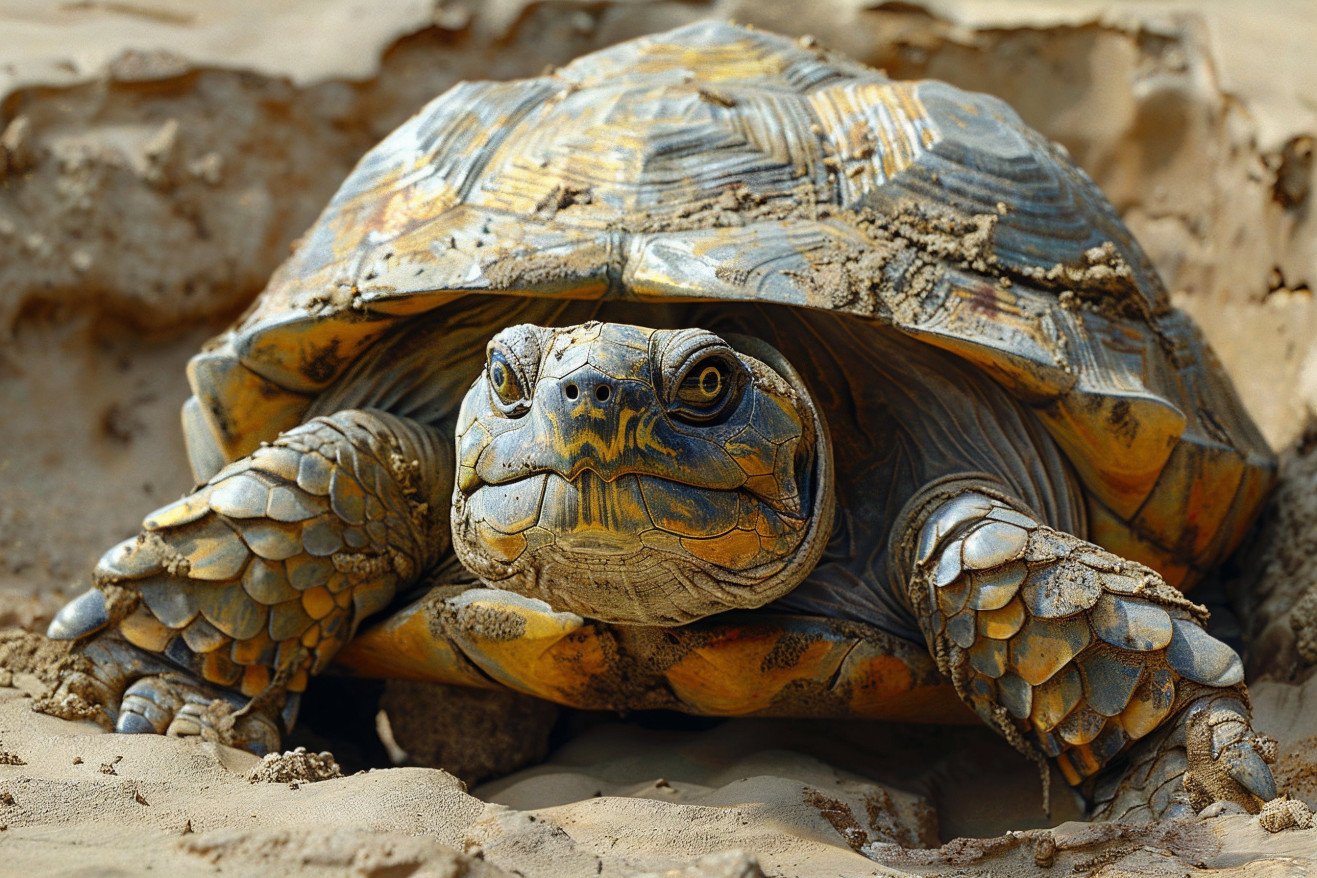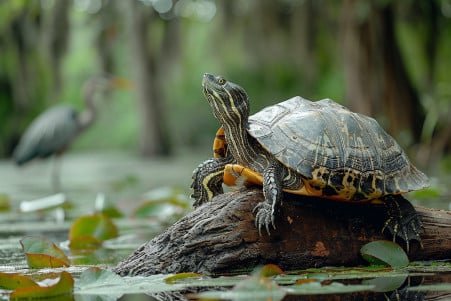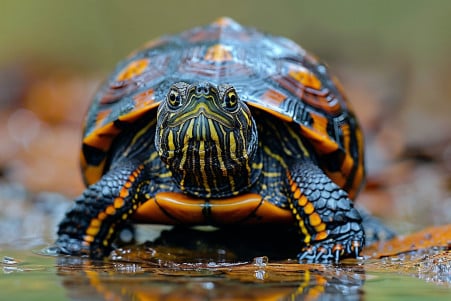Did Turtles Evolve From Dinosaurs? A Look at the Evolutionary Clues
4 April 2024 • Updated 2 April 2024

Although turtles and dinosaurs were among the earliest reptiles to evolve, the relationship between these groups and whether turtles can be considered dinosaurs has been a matter of contention in the field of paleontology. Are turtles dinosaurs? No, turtles are reptiles that are more closely related to crocodiles and birds, while dinosaurs were a group of reptiles that died out about 66 million years ago at the end of the Cretaceous period.
To better understand this fascinating connection, we will explore fossil and molecular evidence that has been used to track the evolutionary history of turtles and dinosaurs over the past hundreds of millions of years. By using genetic research and anatomical studies, new findings have started to emerge that show how the evolution of modern turtles happened alongside that of dinosaurs and when turtles' ancestors split off from the ancestors of dinosaurs. This evidence-based investigation will help to clarify where turtles fit in the reptile family tree.
Are Turtles Dinosaurs?
Evolutionary History of Turtles
The oldest known turtles go back to the Late Permian Epoch, about 260 million years ago, before the rise of the dinosaurs. As noted by Britannica, early turtle species such as Eunotosaurus africanus and Odontochelys semitestacea didn’t have fully formed shells but did have broad, flat ribs and partial shells. By the time of Proganochelys quenstedi, which lived during the Early Triassic about 214 million years ago, most of the major features of modern turtles were in place, including a complete carapace or upper shell.
There are three main ideas about where turtles fit in the reptile family tree, but there is still no agreement about which group of reptiles turtles are most closely related to. One idea is that turtles are the sister group to the archosaurs (dinosaurs, crocodiles, birds), another is that they are most closely related to lizards and tuataras, and a third is that they are anapsids, which means they are not closely related to any living reptiles and have no openings in their skulls according to Britannica.
Fossil evidence, including Proterocheris, indicates that the two major groups of living turtles, Pleurodira (side-necked) and Cryptodira (hidden-necked), split by the Triassic Period, about 230 million years ago, according to Britannica. This means that turtles are an ancient group that had evolved their unique shells and body plan tens of millions of years before the first dinosaurs, as explained in ThoughtCo’s summary of the history of turtles.
Turtles' Relationship to Dinosaurs and Birds
New genetic research, including the use of Ultra Conserved Elements (UCE), has led to a reorganization of the turtle family tree. According to the California Academy of Sciences, UCE analysis has confirmed that turtles are more closely related to the archosaur group that includes birds, crocodiles, and dinosaurs than to snakes and lizards. This has resulted in the establishment of a new reptile group, Archelosauria, that includes turtles, birds, crocodiles, and their prehistoric relatives.
The presence of the gene CYP2J19 in both turtles and birds indicates that their common dinosaur ancestors may have had the ability to see in color. As noted by Phys.org, the gene enables birds and turtles to metabolize yellow pigments into red, which allows them to see in the red part of the color spectrum. Since dinosaurs diverged from the archosaur lineage after turtles, the fact that the "red gene" is present in the group's common ancestor suggests that dinosaurs also had the ability to see in color.
Although turtles are not direct descendants of dinosaurs, they do have a common ancestor with dinosaurs in the archosaur lineage. This is supported by the fact that a new species of turtle fossil from the Cretaceous period, which lived at the same time as dinosaurs 90 million years ago, has been discovered, as noted by Arizona State University.
Major Evolutionary Adaptations That Set Turtles Apart From Dinosaurs
Despite their common archosaur ancestry, turtles and dinosaurs evolved very different body plans and adaptations. As noted by The Atlantic, the turtle shell likely first evolved for digging and burrowing, with the ribs acting as anchors before eventually becoming a form of protective armor. This is an example of exaptation, in which a trait that evolved for one purpose is later adapted for a different use.
In contrast, dinosaurs evolved a wide range of body forms and sizes that were adapted to a variety of ecological roles, including large herbivores and carnivorous hunters. According to The Olive Ridley Project, differences in the turtle's anapsid skull and fused shell bones set it apart from the diapsid reptile ancestors of dinosaurs. This suggests that despite their shared ancestry, turtles and dinosaurs evolved along very different paths.
As noted by the Smithsonian Insider, the discovery of transitional fossils like Pappochelys has helped to shed light on the separate evolution of the turtle shell and body plan from that of dinosaurs. While both groups can trace their lineage back to archosaurs, turtles evolved their unique adaptations tens of millions of years before the first dinosaurs appeared on Earth.
Conservation Issues for Modern Turtles
More than half of the world's 360 turtle and tortoise species are at risk of extinction due to human activities, according to a report by the Natural Resources Defense Council. The most significant threats are loss of habitat, hunting for food and the pet trade, pollution, and the impacts of climate change.
While Asia has the highest diversity of turtle species, it also has the most species at risk due to exploitation, according to WWF. Unlike the mass extinction that wiped out the dinosaurs, turtles are facing human-made threats that they are not biologically equipped to handle, unlike the natural threats that led to the extinction of the dinosaurs.
According to Phys.org, at least 171 species of turtles are currently threatened, and five species and subspecies have been lost in historical and recent times. The conservation of wetland and coastal ecosystems is essential to the survival and recovery of turtle species, as their habitats have been reduced to a fraction of their original size.
Human-made threats, not natural predators, are the main reason sea turtle species are on the brink of extinction, according to the Sea Turtle Conservancy. The most significant threats to sea turtles today are commercial fishing, marine debris, coastal development, and climate change.
Turtles' Resilience and Prospects for Survival
Turtles have survived several mass extinctions, including the one that wiped out the dinosaurs, but their future is now in peril due to the current human-driven extinction crisis.
One study that looked at the diversity of non-marine turtles over the past 230 million years found that while some turtle species went extinct after the asteroid impact, many did not. In fact, the number of turtle genera peaked about five million years after the asteroid impact, indicating that turtles were able to survive and thrive in the wake of the mass extinction event.
Turtles' aquatic habitats and temperature tolerance may have helped them survive past extinction events and contributed to their ability to diversify. However, the study also points out that there are important differences between the past and present that make it challenging to draw direct parallels between the two. The current climate crisis and human-driven habitat loss are new threats to turtles that did not exist in the past.
Protecting and restoring wetlands and river deltas may be especially important for the survival of turtles in the present day. With their ancient lineage, turtles provide an opportunity to preserve a unique branch of biodiversity if we can reduce the impact of human-driven threats on their populations.


